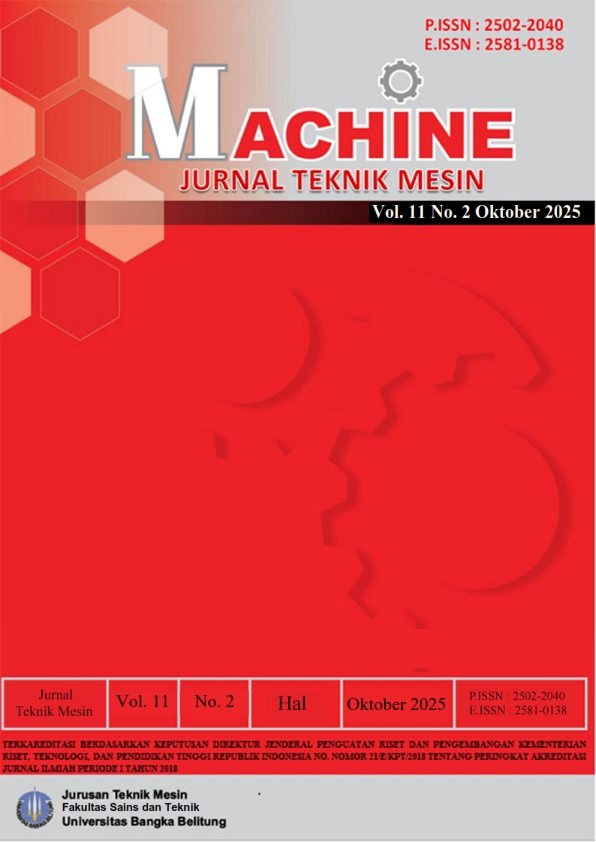Evaluasi Torsi Electric Engine Prototipe Perahu Listrik Nelayan Menggunakan Metode Prony Brake
DOI:
https://doi.org/10.33019/t7gczp80Keywords:
Electric Engine, Prony Brake, TorqueAbstract
Teknologi perahu nelayan berbasis sistem penggerak motor listrik telah dikembangkan sebagai salah satu inovasi kendaraan laut. Perahu listrik dapat bergerak dengan adanya gaya torsi yang dihasilkan dari motor listrik untuk memutar poros motor yang terhubung dengan propeller. Tujuan penelitian ini adalah mengevaluasi gaya torsi yang dihasilkan oleh electric engine dengan metode prony brake. Metode penelitian adalah eksperimental dengan pendekatan terhadap variasi beban, variasi diameter eksternal pully poros motor, dan variasi putaran motor. Hasil perhitungan eksperimen menunjukkan bahwa pengujian prony brake dapat digunakan sebagai instrumen dalam metode pendekatan untuk menghitung torsi. Nilai torsi dipengaruhi oleh diameter pulley, variasi beban, dan variasi putaran awal motor. Nilai torsi terbesar pada variasi beban dan diameter pulley yakni pada diameter pulley 3 inchi dan beban 8 kg, yakni 3,10 Nm. Perubahan putaran poros motor (rpm) mempengaruhi peningkatan torsi. Nilai torsi terbesar pada variasi putaran yakni pada 800 rpm dan beban 8kg pada setiap variasi diameter; 4,31 Nm (2 inchi), 5,34 Nm (2,5 inchi), 6,46 Nm (3 inchi). Torsi yang diperoleh digunakan sebagai acuan dalam menentukan kemampuan electric engine dan kemampuan prototipe perahu nelayan selama beroperasi di laut.
Downloads
References
[1] S. S. Tumigolung, F. P. T. Pangalila, and F. E. Kaparang, “Studi tentang Pengaruh Perbedaan Daya Mesin terhadap Kecepatan dan Konsumsi Bahan Bakar Minyak pada Perahu Pakura,” J. Ilmu dan Teknol. Perikan. Tangkap, vol. 2, no. 5, pp. 187–193, 2017.
[2] A. Boretti, “Advantages and Disadvantages of Diesel Single and Dual-Fuel Engines,” Froontiers Mech. Eng., vol. 5, no. 12, pp. 1–15, 2019, doi: 10.3389/fmech.2019.00064.
[3] M. H. N. Aliffrananda, A. R. Safaruddin, H. Supomo, and S. Regitasyali, “Design of laminated bamboo fishing boat with local cultural heritage using electric motor to support fishing tourism in Pasuruan , East Java,” IOP Conf. Ser. Mater. Sci. Eng., vol. 1052, no. 1, pp. 1–16, 2021, doi: 10.1088/1757-899X/1052/1/012032.
[4] R. Reabroy, Y. Tiaple, S. Pongduang, and T. Nantawong, The Possibility of using Electrical Motor for Boat Propulsion System, vol. 79. Elsevier B.V., 2015. doi: 10.1016/j.egypro.2015.11.601.
[5] M. Mehedi and T. Iqbal, “Optimal Sizing of a Hybrid Power System for Driving a Passenger Boat in Bangladesh,” Conf. Pap., vol. 2, no. 3, pp. 1–6, 2020, doi: 10.1109/EPEC48502.2020.9319920.
[6] D. Harjono, W. Widodo, H. Sugiarto, and A. Bakar, “Analisis Kapasitas Dan Pengisian Baterai Pada Mobil Listrik Ponecar,” Electrotech. Inf. Technol., vol. 3, no. 1, pp. 1–10, 2022.
[7] V. T. Tuan, P. N. Huy, S. Phoemsapthawee, and S. Kreuawan, “E-Engine for a Long-Tail Boat , an Application in ASEAN ( Association of Southeast Asian Nations ) -Design and Comparison with Internal Combustion Engine,” World Electr. Veh. Joirnal, vol. 12, no. 36, pp. 1–11, 2021.
[8] A. Amiadji, A. Baidowi, and A. Nanda Oktova, “Impact Analysis of Trim Tab Inclination Angles Variation to Propulsion Power Requirement of 6 Meter’s Speed Boat,” Int. J. Mar. Eng. Innov. Res., vol. 6, no. 3, pp. 175–184, 2021, doi: 10.12962/j25481479.v6i3.10639.
[9] Muh. Irbabunnuha A, Y. M. Sholihin, and M. D. Trisno, “Rancang Bangun Alat Uji Torsi Tipe Prony Brake Untuk Unjuk Kerja Mesin Motor Bakar Kapasitas 6,6 Kw,” Teknobiz J. Ilm. Progr. Stud. Magister Tek. Mesin, vol. 10, no. 3, pp. 20–24, 2020, doi: 10.35814/teknobiz.v10i3.1759.
[10] F. Laamena and A. Taihutu, “Kajian Optimasi Ukuran Kapal Tradisonal dan Perhitungan Hambatannya,” J. Metiks, vol. 1, no. 1, pp. 17–22, 2021.
[11] D. Belinda, Siswoyo, and B. Setiadi, “Rancang Bangun Dynamometer Model Prony Brake untuk Alat Uji Motor Listrik,” Pros. Ind. Res. Work. Natl. Semin., pp. 269–274, 2022, [Online]. Available: https://jurnal.polban.ac.id/ojs-3.1.2/proceeding/article/view/4269
[12] R. Hadiputranto, “Brake Untuk Sarana Praktikum Prestasi Mesin,” J. Ilm. Tek. Mesin, vol. 7, no. 1, pp. 11–18, 2015.
[13] I. Herry and R. A. Pathur, “Pengujian Dinamometer Prony Brake Untuk Praktikum Prestasi Mesin Motor Diesel,” Univ. Lambung Mangkurat, vol. 3, no. 1, pp. 28–34, 2014.
[14] H. Maghfiroh, A. J. Titus, A. Sujono, F. Adriyanto, and J. S. Saputro, “Induction Motor Torque Measurement using Prony Brake,” Int. J. Robot. Control Syst., vol. 2, no. 3, pp. 594–605, 2022, doi: http://doi.org/10.31763/ijrcs.v2i3.782.
[15] S. Tjandra, A. Suhartono, and T. Salim Suswanto, “Simplification of the Prony Brake Dynamometer System Using Brake Caliper Load,” Int. J. Sci. Technol. Manag., vol. 4, no. 5, pp. 1351–1357, 2023, doi: 10.46729/ijstm.v4i5.920.
[16] M. Yahya, T. Sukmadi, and B. Winardi, “Perancanaan modul prony brake untuk penentuan karakteristik mekanik (torsi terhadapkecepatan) dan efisiensi motor induksi 3 fasa,” Depaetemen Tek. Elektro, Univ. Diponogoro, Semarang., vol. vol 5, p. 421, 2016.
[17] R. N. Situmorang, P. Manik, and A. Wi. B. Santosa, “Analisa Nilai Thrust Optimum Propeller Pada Kapal Tugboat Pelabuhan Paket-II 2x1850HP Dengan Variasi Diameter Propeller, Jumlah Daun Propeller & Kecepatan Putaran Propeller(RPM),” J. Tek. Perkapalan, vol. 8, no. 3, pp. 112–116, 2020.
Downloads
Published
Issue
Section
License
Copyright (c) 2025 Machine : Jurnal Teknik Mesin

This work is licensed under a Creative Commons Attribution 4.0 International License.
The paper presented is assumed not to contain proprietary materials that are not protected by patents or patent applications. Responsibility for technical content and for protection from proprietary materials is the responsibility of the author and their organization and not the responsibility of the machine or its editorial staff. The primary author (first / appropriate) is responsible for ensuring that the article has been viewed and approved by all other authors. It is the responsibility of the author to obtain all copyright release permits required for the use of any copyrighted material in the manuscript before submission.











